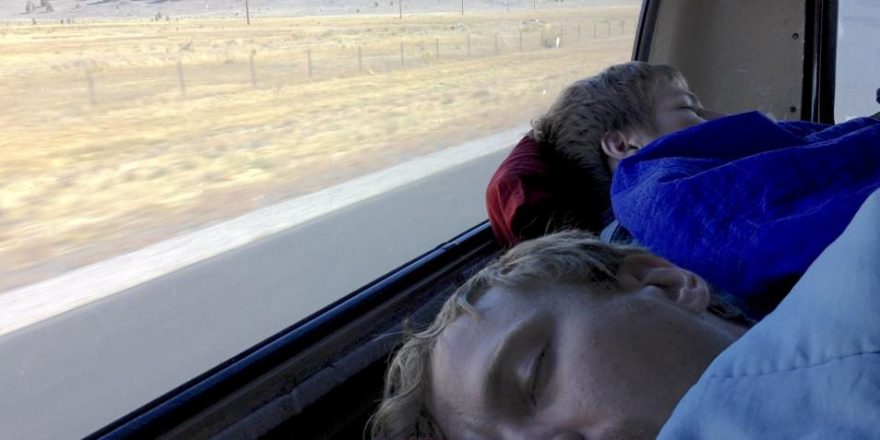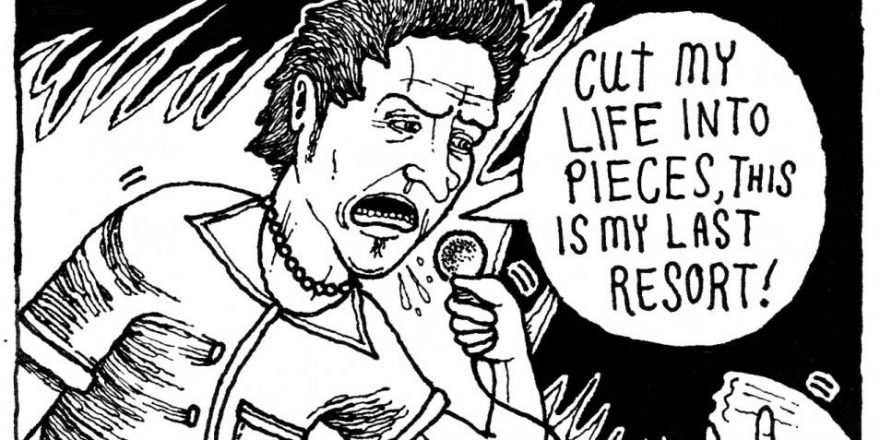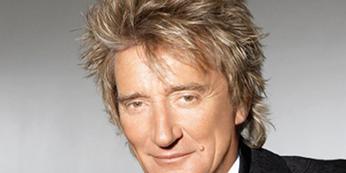“As regards a fellow-traveler, the question always comes up — how far will he go?”
—Leon Trotsky, Literature and Revolution, 1924
There’s a stretch of Texas where it’s always night, as far as I know. It’s somewhere between Ozona and Van Horn, along I-10, and since we’re always starting west from Austin, or limping home from Phoenix, by the time we get there, it’s dark. There’s a ruined schoolhouse in Kent, Texas where we usually stop to stretch our legs, a beautiful spot. The sun’s always rising or setting there, and Indian paintbrush grows among broken bottles and mostly good-natured graffiti. Black-throated sparrows buzz and squeak in the creosote bushes, whose tiny leaves and yellow flowers, crushed between your finger and thumb, smell like rain. The gas station on the other side of the overpass doesn’t look open, but it doesn’t matter; they took the door off the men’s room long ago in exchange for never cleaning it, ever.
________________________
Scenes like this make up most of touring life, and in a way they’re the most real parts of it, when you feel like you’re alone in the world. Touring means constant motion and constant routine, and the one thing you can count on, besides a searing intimacy with your bandmates and the van you’re crammed into, is that every other place and person you see will be long gone tomorrow. This does funny things to your mind. It makes almost anything seem possible. It also makes the people you’re traveling with seem like the only other three-dimensional beings in the universe.
________________________
A turnout above the painted desert, Arizona, late afternoon. You stop noticing the roar of the van after a while, so when we pull up and cut the engine we’re all struck by the eerie, silken absence of sound in such a grand scene. No planes, no cars, no voices — just ochre-and-cream badlands stretching north to the horizon. A fermata hangs over the moment. Then there’s a deep quoork, echoing off the cliffs below, and a raven pops over the lip of the canyon, alights in the parking lot, and looks us over. He’s mesmerizing — intensely black with a silver sheen, a massive bill, and a lightness in his step that magnifies his presence. Someone suggests he might want a pita chip. I tiptoe back to the van, fish a handful out of last night’s rider, and toss them toward the raven. It takes a few steps in my direction, picks up a chip, and hops into the canyon, quoorking again. A few seconds later, he (or she) reappears with a mate; they share the rest and leave together, and the silence folds itself around them. They’ve got their act worked out, too.
________________________
Every band has its own culture — paranoid, hedonic, groovy, introverted — and it doesn’t always resemble their music; guesses about what they’ll be like can be way off. It’s weird to see the same five people every night for a month and never really speak to each other, but it happens — as do rivalries, flirtations, prank wars and friendships. My favorite tours are the ones where you slowly warm to the other camp and then exchange hugs, addresses, even a few tears on the last night, before turning off on your own paths again. If you’re opening a tour where the headliner travels all night in their bus while you drive all day in your van, you turn up at each venue to find a crew of people and a mountain of gear that seems like it was always there, like you’ve arrived at the place you just left.
________________________
A rest area in the Columbia Gorge, heading west from the high plains. We’ve barely rolled to a stop when Thor, our drummer, bolts from the van; he can’t take another minute inside. I’m sullen and tired, and I’m watching him tear off into the desert, his hair flying out behind him in the sun. It snaps me out of my funk, and I jump out after him, yelling Come back here, hippie! and chase him into the sagebrush until I’m gasping. It feels like I’ve just entered a new chapter of my life in which I’m fated to pursue him like a bounty hunter after Butch Cassidy, all the way to Patagonia.
________________________
Constitution Avenue, DC. We park for the afternoon and come back to find we’ve been robbed; the faint handprint of one of the thieves stays on the front passenger door for the rest of the tour. They took bags, phones, psych meds (not a euphemism). But all our instruments are still in the back, which feels a little insulting until I imagine someone tear-assing down the street with a kick drum. Everyone feels violated; we’re 200 yards from the fucking Constitution of the United States, on a street crawling with police, and they can’t stop a break-in in broad daylight? The cop who takes our story is polite, but I think he’s trying to keep a straight face. He scribbles in his notepad. We ask if this is normal. Oh, yeah, he says. It happens all the time.
________________________
UK immigration, Dover ferry terminal. The officer doesn’t like our work permits. This is all wrong, he says, turning the pages upside down, holding them up to the light. He looks severely through our passports and is especially unhappy with mine, which is frayed at the edges and has stamps that don’t jibe with our alleged profession: Namibia, Madagascar, Argentina. Then his expression softens. “You play many shows in the Falklands?” he asks. “Just one,” I admit. It was at the Globe Pub in Stanley, in October 1997; I played guitar with a band of construction workers called the Crucifiers. He waves us through.
________________________
Dressing room graffiti in Baton Rouge, Louisiana: I FUCKED YOUR MOTHER LAST NIGHT. Below it: GO HOME DAD, YOU’RE DRUNK.
________________________
Dressing room graffiti in Tallahassee, Florida: I FUCKED YOUR MOTHER AND NOW I AM A MOTH.
________________________
Dressing room graffiti in Manchester, UK: DOES THIS PATH HAVE A HEART, IS THE ONLY QUESTION.
________________________
Chris Martin is sweating, breathing hard, a bit wild-eyed. It’s a little over halfway through Coldplay’s second night at the Forum, and the four of them just came sprinting into the backstage after playing some acoustic songs up in the cheap seats. There’s segue music booming in the big room, after which they’ll reappear on the main stage with its video screens, lasers and confetti cannons. I wasn’t expecting to see them working so hard. Actually, I don’t know what I was expecting at all. When we drove our little van into the underbelly of the arena, past their fleet of semis, I realized how far out of our element we were. Even more so when I heard the whoomp of the kick drum bouncing off the back wall during our sound check — nearly half a second later. How did Zeppelin do it in here?
________________________
Most surprising is that Coldplay are very kind to us. They pay us well, feed us from their catering, stop by to geek out about Eno. As we climb the ramp to the stage each night, we even get about 15 seconds of their applause. At the last show, I bellow “Hello, Las Vegas!” to 20,000 people for the first (and, I’m sure, only) time in my life, and they go nuts. I can’t believe it works. The next morning, we’re headed back to the clubs, and it’s both a comedown and a relief. A few miles outside of town, we see a man on the shoulder who’s pushing a shopping cart full of black plastic bags into the Nevada desert. He doesn’t look up as we pass.
________________________
Worn sticker on Sharon Van Etten’s laptop: EVERYTHING WILL BE OK.
________________________
People sometimes offer me this nugget of wisdom: they’ve heard that bands don’t make money by selling records any more, but there’s still money in live shows, right? But touring is like the rest of American life — only the famous bands make money. The rest of us are doing it for some other reason.
________________________
Back on I-10, well after midnight, just west of the Texas border. After the sci-fi scenes of El Paso and Juarez, I hit the wall around Las Cruces; the road starts to blur. If nobody’s up to drive till dawn we suck it up and stop there, cramming everybody in one room for a few hours. Two of us pay while the rest saunter around back. One night we hit the lights and the walls come alive with lurid green pentagrams, wolves’ heads, stuff like that, drawn in glow-paint. It’s beautiful.
________________________
Years later, in New York, I meet a Texan writer who tells me that way down the Rio Grande, where it’s joined by the Pecos, there’s a huge panel of pictographs on private land. It’s more than 4,000 years old. Its immense figures depict a headless moon goddess, a deer impaled on thorns and a world spangled with peyote buttons. They were painted by people whose names and lives we’ll never really know. All we know is this: that they wandered across this desert, following water, following animals, following the lights by which they knew their world — and that they lived, and died, by ephemeral pools.
[Editor’s note: a much longer version of this piece originally appeared in the liner notes for the vinyl edition of Shearwater’s 2013 covers album Fellow Travelers. If you’d like to read the whole thing, buy the record, it’s good!]







